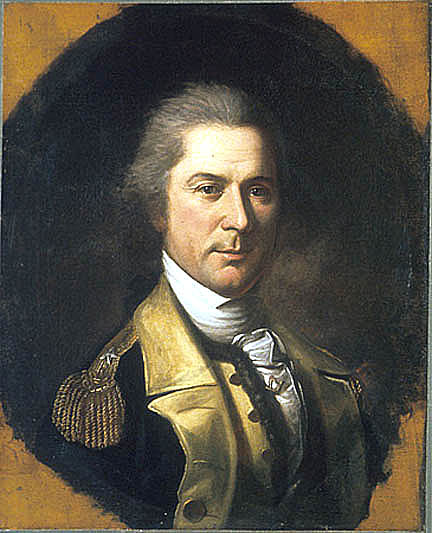
 |
|||||||||||
| OTHO HOLLAND WILLIAMS 1749-1794 by Charles Willson Peale, after Charles Willson Peale, 1782-1784 Oil on canvas. H 23, W 19 in (H 58.4, W 48.3 cm) Independence NHP INDE 14164
|
|||||||||||
|
About this Portrait:
Charles Willson Peale's museum portrait of Williams appeared on the list published in the October 13, 1784 issue of the Freeman's Journal and Philadelphia Daily Advertiser. The museum portrait appears to be a copy of a similar portrait (destroyed in 1977) painted for the Williams family. The museum replica lacks both the life portrait's background material (a classical temple labeled "MARS," which represents the Williams' military prowess) and a Society of the Cincinnati eagle medal. Peale recorded that he had added these to William's picture in late 1788. In addition, Peale also changed the color of Williams's stock (neckcloth) from black (in the life portrait) to white (in the replica). There are many Peale-related images of Williams. All combine various elements of the life and museum portraits. Both Charles Willson Peale's 1780s miniature of Williams and Rembrandt Peale's 1796 copy of the Williams museum portrait depict Williams without a Cincinnati medal and wearing a white stock. Sarah Miriam Peale, Rembrandt's cousin, included these aspects in her c. 1830 copy of the Williams life portrait (with its classical temple). James Barton Longacre copied most of the museum portrait's elements for his engraved portrait of Williams published in The National Portrait Gallery of Distinguished Americans (1834-1839). In the engraving, Williams wears a white stock and a Cincinnati medal (Longacre also altered the trim on Williams's waistcoat to brocade and buttoned his collar). Listed in the 1795 Peale Museum catalog. Purchased by the City of Philadelphia at the 1854 Peale Museum sale. |
|||||||||||
|
|||||||||||
|
|
||
|
Note: Prev/next are in alphabetic order within their respective theaters. |
||
Last Modified: